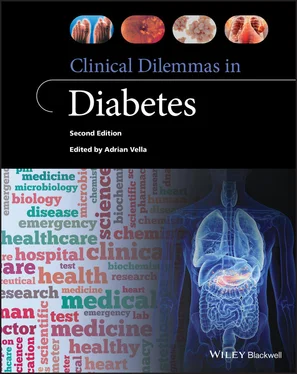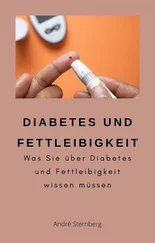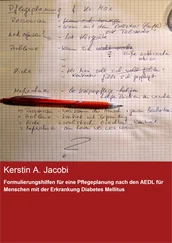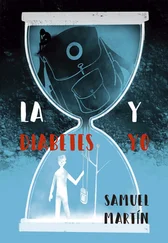Shubhada JagasiaDivision of Diabetes, Endocrinology and Metabolism Vanderbilt University Medical Center Nashville, TN USA
Ravinder Jeet KaurDivision of Endocrinology, Diabetes, Metabolism and Nutrition Mayo Clinic Rochester, MN USA
Jacob KohlenbergDivision of Endocrinology, Diabetes, Metabolism, and Nutrition Mayo Clinic Rochester, MN USA
Yogish C. KudvaDivision of Endocrinology, Diabetes, Metabolism and Nutrition Mayo Clinic Rochester, MN USA
Blandine LaferrèreDivision of Endocrinology, Diabetes and Nutrition Obesity Research Center Department of Medicine St Luke's Roosevelt Hospital Center Columbia University College of Physicians and Surgeons New York, NY USA
Chiam Leker LockerDepartment of Cardiovascular Disease Mayo Clinic Rochester, MN USA
Madeline K. MahowaldDepartment of Cardiovascular Disease Mayo Clinic Rochester, MN USA
John M. MilesUniversity of Kansas Kansas City, KS USA
Kalpana MuthusamyDivision of Endocrinology Olmsted Medical Center Rochester, MN USA
Timothy O'BrienDepartment of Medicine and Endocrinology/Diabetes Mellitus University College Hospital Galway and National University of Ireland Galway Ireland
Aonghus O'LoughlinDiscipline of Medicine NUI Galway Galway Ireland and Centre for Diabetes, Endocrinology and Metabolism Galway University Hospitals Galway Ireland
Silvia PieraliceDepartment of Endocrinology & Diabetes Campus Bio‐Medico University of Rome Rome Italy
Paolo PozzilliDepartment of Endocrinology & Diabetes Campus Bio‐Medico University of Rome Rome Italy
Philip RaskinClifton and Betsy Robinson Chair in Biomedical Research University of Texas Southwestern Medical Center at Dallas Dallas, TX USA
John W. Richard IIIDivision of Endocrinology, Diabetes, Nutrition and Metabolism University of Texas Southwestern Medical Center at Dallas Dallas, TX USA
Shafaq R. RizviDivision of Endocrinology, Diabetes, Metabolism and Nutrition Mayo Clinic Rochester, MN USA
Meera ShahDivision of Endocrinology, Diabetes, Metabolism, and Nutrition Mayo Clinic Rochester, MN USA
Vinaya SimhaDivision of Endocrinology, Diabetes, Metabolism and nutrition Mayo Clinic Rochester, MN USA
Mandeep SinghDepartment of Cardiovascular Disease Mayo Clinic Rochester, MN USA
Steve A. SmithDivision of Endocrinology, Diabetes, Metabolism, and Nutrition Mayo Clinic Rochester, MN USA
Saritha TirumalasettySection of Endocrinology Tulane University School of Medicine New Orleans, LA USA
Adrian VellaDivision of Endocrinology, Diabetes, Metabolism, and Nutrition Mayo Clinic Rochester, MN USA
Alexander J. WilliamsDivision of Diabetes, Endocrinology, and Metabolism Vanderbilt University Medical Center Nashville, TN USA
While a week may be a long time in politics, the decade that has elapsed since the original publication of Clinical Dilemmas in Diabetes could be considered to be a very (very) long time given the developments in clinical practice that occurred. New therapeutics for the treatment of dyslipidemia and diabetes have appeared. Progress in the development of an artificial pancreas and in sensor technology has improved the care of type 1 diabetes and some diabetes medications may directly alter cardiovascular outcomes. However, the original motivations behind the book—translating trial data into clinical practice—remain very relevant. The astute clinician will need to balance risks and benefits, convenience and cost with changing clinical needs, comorbidities, and patients’ social structures.
As before, the topics covered deserve discussion and debate to avoid making every square peg fit into the round hole of an algorithm or guideline. There has been an expansion in the areas covered, reflecting my initial desire for a book that reflects the growing facets of metabolic care.
I would like to express my gratitude to Dr. Robert A. Rizza MD, who served as a co-editor for the first edition of the book and as always serves as a sounding board for many of my ideas. None of this would have been possible without him. Of course, the other important characters in this saga would be my parents—especially my father, who has now retired from General Practice—but whose approach to problems I have always tried to emulate. Last, but not least, I am very grateful to my wife Elsa, who hung on gamely while I edited proofs of the first edition during our honeymoon, and to our children Katie and Lucy, who are always along for the ride.
PART I Prediabetes and the Diagnosis of Diabetes
1 “Is Prediabetes a Risk Factor or Is It a Disease?”
Jacob Kohlenberg1 and Adrian Vella2
1Fellow and Instructor in Medicine, Division of Endocrinology, Diabetes, Metabolism, and Nutrition, Mayo Clinic, Rochester, MN, USA
2Professor of Medicine, Division of Endocrinology, Diabetes, Metabolism, and Nutrition, Mayo Clinic, Rochester, MN, USA
Prediabetes is a heterogeneous condition with variable risk of progression to type 2 diabetes
In addition to diabetes risk, it is associated with an increased risk of vascular disease.
To date, lifestyle modification is the single most important tool for altering the natural history of prediabetes and progression to type 2 diabetes.
Prediabetes is defined as an elevated fasting plasma glucose (FPG), and/or an elevated 2‐hour plasma glucose (2‐h PG) during a 75‐gram (g) oral glucose tolerance test (OGTT), and/or an elevated Hemoglobin A1c (HbA1c), without meeting diagnostic criteria for overt diabetes mellitus (DM) [1]. The 2020 American Diabetes Association (ADA) Guidelines define prediabetes as impaired fasting glucose (IFG) with a FPG of 100–125 mg/dL, and/or impaired glucose tolerance (IGT) with a 2‐h PG during a 75‐g OGTT of 140–199 mg/dL, and/or a HbA1c of 5.7–6.4% [1]. In contrast to the ADA, the 2016 World Health Organization (WHO) Guidelines define intermediate hyperglycemia as IFG between 110–125 mg/dL and/or IGT with a 2‐h PG during a 75‐g OGTT between 140–199 mg/dL [2]. Unlike the ADA, the WHO does not include HbA1c as a diagnostic criterion for prediabetes.
The definitions of both prediabetes and DM have evolved in recent decades. The WHO first defined the “borderline state” in 1965 as a 2‐h PG during a 50 or 100 g OGTT between 110–129 mg/dL [3]. The ADA has long recognized IGT, and its definition has undergone little change since its inception. First adopted by the ADA in 1997 and WHO in 1999, the term IFG was originally defined as FPG 110–125 mg/dL [4]. However, in 2003, the ADA revised the criteria for IFG to 100–125 mg/dL based on data from multiple studies showing that the risk of DM increases markedly at a FPG concentration > 100 mg/dL [5]. In 2010, the ADA added HbA1c as a diagnostic criterion for prediabetes because the relationship between HbA1c and the risk of retinopathy was similar to corresponding FPG and 2‐h PG thresholds [6].
Rationale for the diagnostic criteria for diabetes mellitus and prediabetes
Individuals with prediabetes have abnormal glucose regulation and increased risk for developing DM type 2 (DM2) and its complications [6]. The diagnostic thresholds for DM are based on [1] the bimodal distribution of FPG and 2‐h PG during an OGTT and [2] the glycemic thresholds for the development of microvascular complications, specifically retinopathy ( Figure 1.1). The bimodal distribution and glycemic thresholds for the development of microvascular complications have been demonstrated in many populations including the Pima, Nauruans, South Africans, Americans, Chinese, and Egyptians [7–15]. The bimodal distribution of glucose has been used to separate individuals into two groups: those with normoglycemia and those with hyperglycemia. IFG and IGT were defined as intermediates between normoglycemia and hyperglycemia. The diagnostic thresholds for FPG, 2‐h PG during a 75‐g OGTT, and HbA1c are relatively concordant in discriminating between the two components of a bimodal frequency distribution and their associations with microvascular complications [4]. It is important to note that defining a lower limit of an intermediate category of FPG, 2‐h PG during a 75‐g OGTT, and HbA1c is somewhat arbitrary because the risk of developing DM is a continuum that extends into the normoglycemic range [6].
Читать дальше












